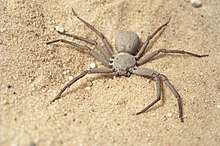Sicarius (spider)
| Six-eyed sand spiders | |
|---|---|
 | |
| Female Sicarius | |
| Scientific classification | |
| Kingdom: | Animalia |
| Phylum: | Arthropoda |
| Subphylum: | Chelicerata |
| Class: | Arachnida |
| Order: | Araneae |
| Infraorder: | Araneomorphae |
| Family: | Sicariidae |
| Genus: | Sicarius Walckenaer, 1847 |
| Species | |
| Diversity | |
| 21 species | |
Sicarius is a genus of spider in the family Sicariidae. In 2017, the genus Hexophthalma was split off from Sicarius; as currently circumscribed, Sicarius is native to South America with one species found in Central America. Sicarius is one of three genera in the family Sicariidae. The venom of its species appears to be less dangerous than that of species of the other two genera, Hexophthalma and Loxosceles.
Habitat and appearance
Sicarius are desert and dry country spiders that live in the Southern Hemisphere in South America (the single exception is the Central American S. rugosus), known primarily for their self-burying behavior. All have six eyes arranged in three groups of two (dyads). Sicarius resembles the crab spiders of the family Thomisidae and the members of the family Homalonychidae. However, Sicarius lacks the characteristic violin-shaped marking of the related recluse spiders. Individual Sicarius can live for as much as 15 years, which makes these among the longest-lived araneomorphae spiders (some tarantulas can live well over 20–30 years), and can live for a very long time without food or water.
Sicarius spiders are between one and two inches in length. The females produce egg sacs covered with a mixture of sand and silk.
Taxonomy
The genus Sicarius was erected by Walckenaer in 1847,[1] with a single species, S. thomisoides. The number of species placed in the genus increased up to 2017, when a phylogenetic study showed that the South African species of Sicarius were distinct, and revived the genus Hexophthalma for them.[2] The species remaining in Sicarius are found in South America, with one species from Central America.[1]
Sicarius is one of three genera in the family Sicariidae, as of July 2018.[3] It is placed in the same subfamily, Sicariinae, as Hexophthalma:[2]
| Sicariidae |
| ||||||||||||
Species
As of July 2018, the World Spider Catalog accepted the following species:[1]
- Sicarius andinus Magalhães, Brescovit & Santos, 2017 – Peru
- Sicarius boliviensis Magalhães, Brescovit & Santos, 2017 – Bolivia, Peru, Brazil, Paraguay
- Sicarius cariri Magalhães, Brescovit & Santos, 2013 – Brazil
- Sicarius crustosus (Nicolet, 1849) – Chile
- Sicarius diadorim Magalhães, Brescovit & Santos, 2013 – Brazil
- Sicarius fumosus (Nicolet, 1849) – Chile
- Sicarius gracilis (Keyserling, 1880) – Ecuador, Peru
- Sicarius jequitinhonha Magalhães, Brescovit & Santos, 2017 – Brazil
- Sicarius lanuginosus (Nicolet, 1849) – Chile
- Sicarius levii Magalhães, Brescovit & Santos, 2017 – Chile, Argentina
- Sicarius mapuche Magalhães, Brescovit & Santos, 2017 – Argentina
- Sicarius ornatus Magalhães, Brescovit & Santos, 2013 – Brazil
- Sicarius peruensis (Keyserling, 1880) – Peru
- Sicarius rugosus (F. O. Pickard-Cambridge, 1899) – El Salvador, Nicaragua, Costa Rica
- Sicarius rupestris (Holmberg, 1881) – Argentina
- Sicarius saci Magalhães, Brescovit & Santos, 2017 – Brazil
- Sicarius thomisoides Walckenaer, 1847 (type species) – Chile
- Sicarius tropicus (Mello-Leitão, 1936) – Brazil
- Sicarius utriformis (Butler, 1877) – Ecuador (Galapagos)
- Sicarius vallenato Cala-Riquelme, Gutiérrez-Estrada, Flórez-Daza & Agnarsson, 2017 – Colombia
- Sicarius yurensis Strand, 1908 – Peru, Chile
Transferred to Hexophthalma
- Sicarius albospinosus = Hexophthalma albospinosa (Purcell, 1908)
- Sicarius damarensis = Hexophthalma damarensis (Lawrence, 1928)
- Sicarius dolichocephalus = Hexophthalma dolichocephala (Lawrence, 1928)
- Sicarius hahni = Hexophthalma hahni (Karsch, 1878)
- Sicarius spatulatus = Hexophthalma spatulata (Pocock, 1900)
Venom components and effects
The spiders of this genus, like those of other species in the family Sicariidae, produce venom containing the necrotic (dermonecrotic) agent, sphingomyelinase D, which is otherwise found only in a few pathogenic bacteria. Species remaining in reduced genus Sicarius appear to have less potent venom than those moved to Hexophthalma.[4][2] Sicariids are found in barren deserts and are able to bury themselves partially in the sand. Because of this, humans seldom come in contact with them.
See also
References
- 1 2 3 "Gen. Sicarius Walckenaer, 1847", World Spider Catalog, Natural History Museum Bern, retrieved 2018-07-16
- 1 2 3 Magalhães, I.L.F.; Brescovit, A.D. & Santos, A.J. (2017), "Phylogeny of Sicariidae spiders (Araneae: Haplogynae), with a monograph on Neotropical Sicarius", Zoological Journal of the Linnean Society, 179 (4): 767–864, retrieved 2018-07-20
- ↑ "Family Sicariidae Keyserling, 1880", World Spider Catalog, Natural History Museum Bern, retrieved 2018-07-17
- ↑ Binford, Greta J. & Wells, Michael A. (2003), "The phylogenetic distribution of sphingomyelinase D activity in venoms of Haplogyne spiders" (PDF), Comparative Biochemistry and Physiology B, 135: 25–33, doi:10.1016/S1096-4959(03)00045-9, retrieved 2018-07-19
External links
| Wikimedia Commons has media related to Sicarius. |
- Arachnology Home Pages: Loxosceles: Recluse spiders
- Biodiversity Explorer: Family Sicariidae (Beautiful photos of Sicarius and Loxosceles)
- Platnick, N.I. 2003. World Spider Catalog.
- Vetter, R. 2003. Causes of Necrotic Wounds other than Brown Recluse Spider Bites.
- Vetter, R. 2003. Myth of the Brown Recluse Fact, Fear, and Loathing.